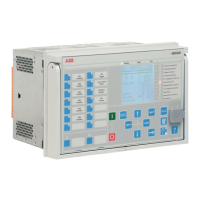4.2.2.9 Application
The directional earth-fault protection DEFxPDEF is designed for protection and
clearance of earth faults and for earth-fault protection of different equipment
connected to the power systems, such as shunt capacitor banks or shunt reactors,
and for backup earth-fault protection of power transformers.
Many applications require several steps using different current start levels and time
delays. DEFxPDEF consists of two different stages.
• Low DEFLPDEF
• High DEFHPDEF
DEFLPDEF contains several types of time delay characteristics. DEFHPDEF is used
for fast clearance of serious earth faults.
The protection can be based on the phase angle criterion with extended operating
sector. It can also be based on measuring either the reactive part Iosin(φ) or the
active part Iocos(φ) of the residual current. In isolated networks or in networks with
high impedance earthing, the phase-to-earth fault current is significantly smaller
than the short-circuit currents. In addition, the magnitude of the fault current is
almost independent of the fault location in the network.
The function uses the residual current components Iocos(φ) or Iosin(φ) according
to the earthing method, where φ is the angle between the residual current
and the reference residual voltage (-Uo). In compensated networks, the phase
angle criterion with extended operating sector can also be used. When the relay
characteristic angle RCA is 0 degrees, the negative quadrant of the operation sector
can be extended with the
Min forward angle
setting. The operation sector can be
set between 0 and -180 degrees, so that the total operation sector is from +90 to
-180 degrees. In other words, the sector can be up to 270 degrees wide. This allows
the protection settings to stay the same when the resonance coil is disconnected
from between the neutral point and earth.
System neutral earthing is meant to protect personnel and equipment and
to reduce interference for example in telecommunication systems. The neutral
earthing sets challenges for protection systems, especially for earth-fault
protection.
In isolated networks, there is no intentional connection between the system neutral
point and earth. The only connection is through the line-to-earth capacitances (C
0
) of phases and leakage resistances (R
0
). This means that the residual current is
mainly capacitive and has -90 degrees phase shift compared to the residual voltage
(-Uo). The characteristic angle is -90 degrees.
In resonance-earthed networks, the capacitive fault current and the inductive
resonance coil current compensate each other. The protection cannot be based
on the reactive current measurement, since the current of the compensation coil
would disturb the operation of the relays. In this case, the selectivity is based on the
measurement of the active current component. This means that the residual current
is mainly resistive and has zero phase shift compared to the residual voltage (-Uo)
and the characteristic angle is 0 degrees. Often the magnitude of this component
is small, and must be increased by means of a parallel resistor in the compensation
equipment.
In networks where the neutral point is earthed through low resistance, the
characteristic angle is also 0 degrees (for phase angle). Alternatively, Iocos(φ)
operation can be used.
In solidly earthed networks, the
Characteristic angle
is typically set to +60 degrees
for the phase angle. Alternatively, Iosin(φ) operation can be used with a reversal
1MRS757644 H
Protection functions
620 series
Technical Manual
409

